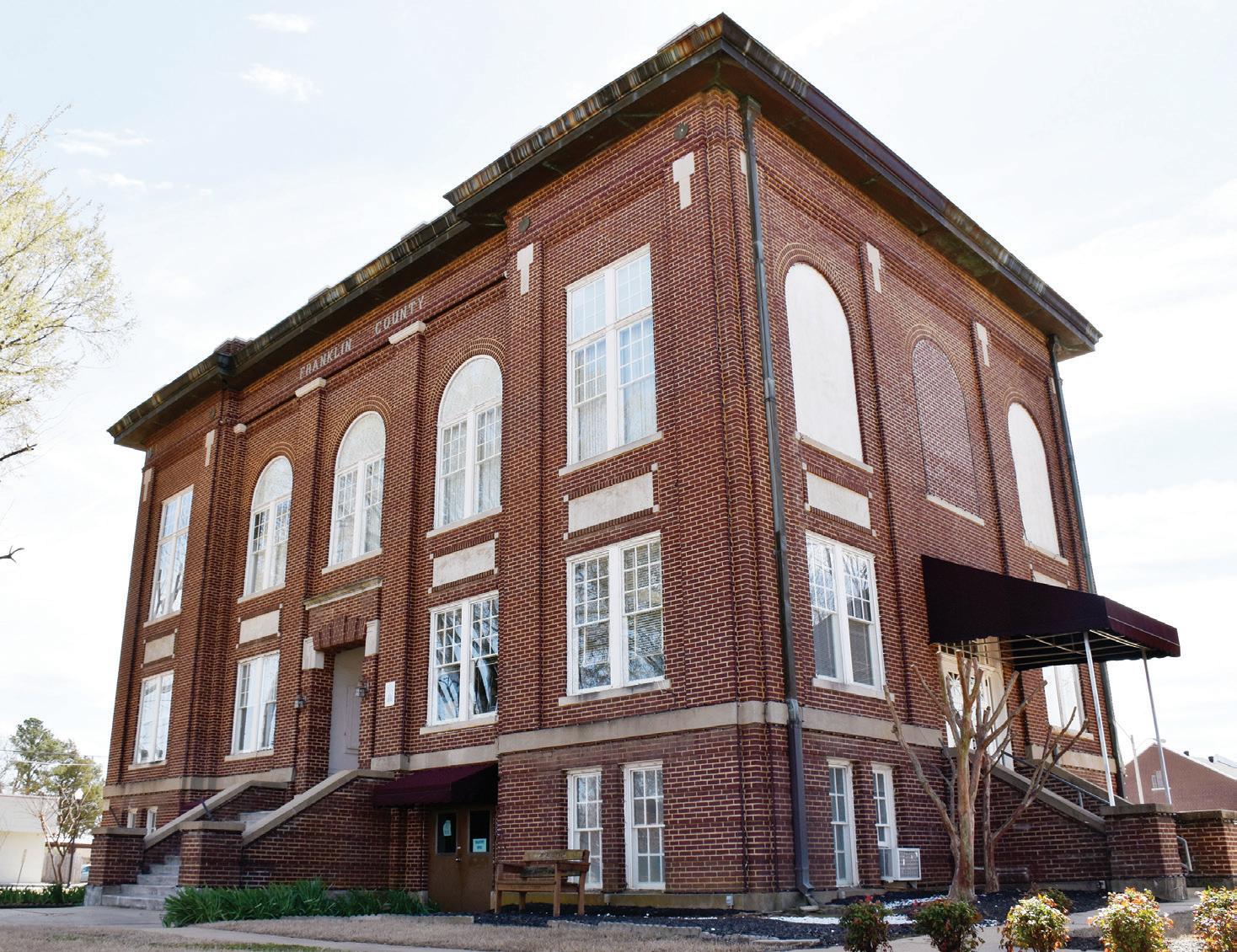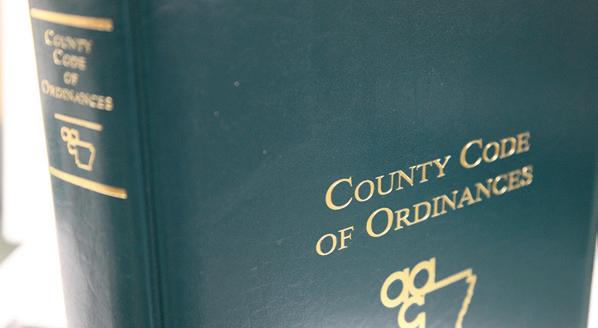
7 minute read
Rising from the ashes
Photo by Christy L. Smith
Above: The first two courthouses in Franklin County’s Northern District of Ozark were either destroyed or damaged by fire. The current building was reconstructed in 1944 incorporating surviving elements of the 1904 builiding, whose second floor burned, and using a “less is more” approach.
Franklin County courthouses rebuilt stronger after multiple fires.
Story by Mark Christ Photos by Holly Hope Arkansas Historic Preservation Program
As with many of the 10 Arkansas counties with dual county seats, Franklin County has a pair of historic county courthouses; though with a 1940s reconstruction of the building in Ozark, Franklin may be able to claim 2 1/2.
Franklin County was created from part of Crawford County in 1837, and Ozark on the Arkansas River was designated its seat of government — a situation that would endure until 1885. The first courthouse was a 20foot square, one-story wood-frame building constructed on the northwest corner of the town square for $400 during the 1839-1840 court term. By 1851 the prosperous county had outgrown the structure and a new two-story brick courthouse was built in the middle of the square with Kendall Webb’s low bid of $2,450. Unfortunately, this structure suffered the fate of many other county courthouses around the state and was burned down during the Civil War.
In 1869, the county accepted a $9,700 bid to construct a new courthouse atop the ashes of the old one, though by the time the sturdy two-story brick building was completed that cost had ballooned to $13,000. Thirty-five years later, the county decided to trade in the plain, square building for
Courthouse
Continued From Page 39 <<<

a new and elaborate structure. Officials hired prolific Little Rock architect Frank W. Gibb on May 2, 1904, and he provided a splendid Italian Renaissance-style design that featured a lofty, 114-foot-tall clock tower, as well as a shorter tower punctuated with an arched arcade. Warren builder Edward L. Koonce, a frequent collaborator with Gibb, was hired to construct the building. The former courthouse was demolished in July 1904 and the new edifice was open for business one year later. It had cost $60,300.
The new building almost suffered the same fate as its 1851 predecessor when a fire started in the flue of a wood stove in the Farm Security Administration office on January 10, 1944. As fire raged on the building’s second floor, courthouse employees and townspeople rushed into the courthouse to move records to safety and local Boy and Girl Scouts helped remove books from the basement library. The inferno gutted the second floor and destroyed the roof, but the first floor and clock tower remained largely intact (in fact, the clock kept time and continued to strike through much of the fire, finally stopping at 10 minutes before 2 p.m.).
County business was moved to the Arcade Building beside the Bank of Ozark as officials weighed their next move. They decided to hire Fayetteville architect T. Ewing Shelton to design a reconstruction of the courthouse incorporating the surviving elements of the 1904 building. Shelton abandoned the architectural excesses of the original structure and instead followed the emerging aesthetic of the International style — a school that embraced the term “less is more.” The reconstructed second floor was faced with buff brick, and the steep hipped roofs from 1904 were replaced with flat surfaces behind parapets. The clock tower was shortened considerably and its original tall, arched windows became rectangular glass-block openings. The other tower was reduced in size until it rose just above the roofline. Interior embellishments were limited to marble wainscoting in the hallways.
Franklin County voters approved a $37,000 bond sale to pay for the “new” courthouse on Nov. 7, 1944, and the final term of court in the Arcade Building adjourned on Aug. 20, 1945. The next term convened in the reconstructed Franklin County Courthouse, Northern District, on Sept. 17, 1945, and county business continues there today.
The story of the southern district courthouse is considerably less dramatic than that of the Ozark building.
Top: An eagle embellishes the Ozark courthouse. Bottom: During reconstruction, interior embellishments were limited to marble wainscoting in the hallways.
A second district was approved for Franklin County on
March 14, 1885, spurred by the difficulty of crossing the
Arkansas River to transact business in Ozark. Charleston was officially designated the southern county seat in 1901, with the Arkansas River serving as the dividing line between the two districts.
Court business was conducted in a two-story stone building in Charleston from 1885 until 1922, when



Left: The hallway of the Franklin County Courthouse at Charleston. Right: The courthouse in Charleston is a stately Colonial Revival building.
the home of the remarkably named Col. John Peregrine Falconer was moved to provide space for a new courthouse. The ubiquitous Frank Gibb was again hired, and he chose a simple but stately Colonial Revival design for the building. The red brick structure features arched windows with fanlights and pilasters that divide the walls into a series of bays with stone panels and capitals providing additional details. The building was officially completed on March 23, 1923, when a memorial stone from Falconer’s chimney was installed in his honor. The $70,000 Franklin County Courthouse, Southern District “is fire proof and is equipped with steam heat and plumbing,” according to the Arkansas Gazette, which perhaps helped it escape the fate of its northern neighbor.
The Charleston courthouse was listed on the National Register of Historic Places on Oct. 18, 1976, while the Ozark Courthouse was listed on Sept. 22, 1995.
Among the many programs and services of the Arkansas Historic Preservation Program is the County Courthouse Restoration Grant Program. Created in 1989, this grant program has helped to extend the lives of courthouses that hold vital links to community pride and local history. These grants are funded through the Real Estate Transfer Tax, administered by the Arkansas Natural and Cultural Resources Council. Since the beginning of the program, the AHPP has awarded more than $22.9 million to 74 historic courthouses and courthouse annexes around the state for use in rehabilitating, preserving and protecting these important historic resources. Since 1989, Franklin County has received 14 grants totaling $478,231 for the two Franklin County Courthouses.
AHPP County Courthouse Restoration Grants awarded for Franklin County Courthouse, Southern District (Charleston)
FY1989 Restoration Master Plan FY1990 Roof repair and brick repointing FY1993 Window restoration, interior repairs FY1997 ADA ramp and electrical upgrades FY1999 Exterior work, electrical upgrades FY2002 HVAC system, electrical panel FY2009 Entrance and masonry restoration FY2015 Stair and porch restoration FY2015 Roof, door and stair restoration $18,000 $23,800 $1,200 $7,500 $2,626 $15,110 $16,274
$15,320 $154,000
AHPP County Courthouse Restoration Grants awarded for Franklin County Courthouse, Northern District (Ozark)
FY1992 Courthouse wall restoration FY1996 Clock and masonry restoration, electrical FY2000 HVAC, replace boiler, window restoration FY2007 Condition assessment, electrical upgrade FY2017 Roof restoration $2,000 $7,500 $25,000 $46,000 $141,901
The AAC Risk Management Fund program offers General Liability, and Auto and Property Protection. The fund is managed by a board of trustees comprised of your county colleagues. As a member, you help develop the fund’s products to meet the needs of our unique and valued county resources and employees.
Our latest added benefit is the Justice Bridge video/audio communication system for law enforcement, prisons and the judiciary. The program allows inmate visits and hearings to be conducted via teleconferenece, provides advancements in parole and probation processes, and improves courtroom safety and efficiency.
Justice Bridge
This innovative program is a simple video/audio communicaiton system for use in circuit and district courts, sheriff’s offices, inmate box portals, and state prisons. Benefits include:

n Reduced inmate transports to court hearings. n Reduced liability due to vehicular accidents, inmate assaults and medical costs. n Reduced contraband in prisons. n Reduced escape potential; increased public safety.


Other AACRMF benefits
Guardian Inmate tracking system
n 20x faster and more defensible than barcode. n Exclusively endorsed by the National Sheriffs’ Association since 2008, the first product in the world to earn this distinction. n The only Inmate Management System in the world that exclusively leverages radio-frequency identification (RFID) technology. n GUARDIAN RFID® Mobile™ is the most widely used mobile app in corrections, actively deployed in 25 states.
Codification of county ordinances

n A single-bound volume of your substantive county ordinances gives you easy access.
n Free CDL drug testing with participation in the RMF Auto Program.
n Your peace of mind partnership for emergency claim services. RMF members receive priority response with participation in the Property Program.
Drug testing


Partnership with Metro to provide P.O.M Services











